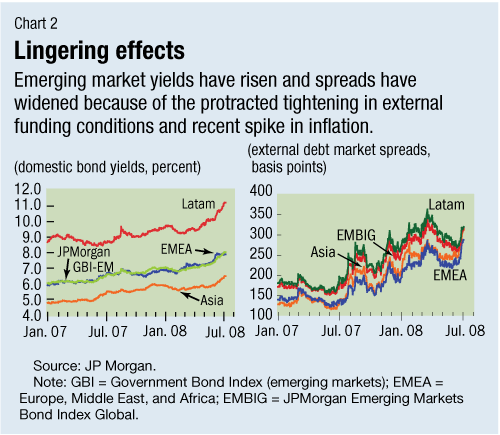
Typical street scene in Santa Ana, El Salvador. (Photo: iStock)
IMF Survey: Market Stresses Testing Managers of Public Debt
August 8, 2008
- Debt forum offers opportunity to explore macro-financial linkages
- Emerging markets in better position to meet challenges
- Central banks cautioned against insufficient response to inflation threat
A combination of rising inflation, slowing world growth, and continued fallout from the U.S. subprime crisis and subsequent market turmoil is making business tougher for policymakers and managers of public debt around the world.

As the crisis lingers, external funding conditions are tightening, with credit spreads and local yields widening. (Photo: Getty)
IMF Public Debt Managers' Forum
Participants at a recent international forum for public debt managers agreed that both mature and emerging markets faced similar key risks to growth and price stability, but that the risks are becoming more pronounced in emerging markets, where inflation is becoming a bigger problem.
Debt managers, central bankers, and representatives of the private sector gathered in Warsaw for the 8th IMF Public Debt Managers' Forum. The July 14-15 Forum attracted participants from a wide-range of emerging and mature market countries. Meetings were co-hosted by the National Bank of Poland and the Polish Ministry of Finance, and were chaired by Murilo Portugal, the IMF's Deputy Managing Director.
Backdrop of rising inflation
In his opening remarks, Portugal highlighted concerns about inflation that is being stoked by higher food and fuel prices. It was important not to allow inflationary expectations to build up into second-round effects such as demands for wage increases. "The historical experience provides ample evidence of how slow and costly it can be to reverse unfavorable expectations once they become established," Portugal stated.
With inflation risks on the rise, the scope for monetary policy to be supportive of financial stability has become more constrained. Fiscal risks have also been increasing, with the scale and impact of fiscal subsidies to fuel and food prices as yet uncertain. In addition, growth prospects look dimmer—just days after the Forum, the IMF revised down its global growth forecasts to 4.1 percent in 2008 and 3.9 percent in 2009, and, in emerging markets, to 7 percent in 2008 (from 8 percent last year).
Relatively resilient
So far, emerging markets have remained relatively resilient to the credit turmoil. In their domestic markets, trading volumes have declined only modestly, and there does not seem to be any visible withdrawal of foreign investors (see Chart 1).

However, as the crisis lingers, external funding conditions are tightening, with credit spreads and local yields widening (see Chart 2), and some emerging markets may come under increased scrutiny. Nevertheless, relative to past crises, interest rate spreads are still significantly lower.
Participants felt that, overall, emerging markets appear to be in a much better position now to meet the challenges than they were some 10 years ago. Learning from the crisis experience, the emerging markets had used the intervening period to lower inflation, consolidate their fiscal position, improve the structure of their debt, and strengthen and deepen their domestic capital markets. Provided that macroeconomic policies remain robust, it seemed that most emerging markets would weather the storm, albeit with higher financing costs.

Responses to market turmoil
Participants at the conference agreed that a response to the current market turmoil requires a combination of policy choices. Current conditions warrant flexibility in operations and might result in changes to existing financing plans, such as adjustments to the mix of debt instruments offered or the volume of issuance, to respond to investors changing needs and demands, and ensuring access to sufficient liquidity by maintaining strong cash reserves, diversifying the investor base, or securing short-term liquidity facilities with, for example, commercial banks.
Examples of changes in the instrument mix mentioned at the conference were the issuance of inflation-linked bonds, in particular, in addition to instruments with shorter maturities and floating rate notes. Active use of liability management operations, such as switches and buybacks, also help mitigate rollover risk. However, it is important to stay committed to an overall medium-term debt strategy and local issuance, and maintain a strong dialogue with investors, participants noted.
Watch out for implicit liabilities
Another area of concern and greater focus for emerging market policymakers are the implicit and explicit contingent liabilities arising from both private sector and guaranteed debt, and the difficulty in making a precise assessment of their scale and associated risks.
The structure of these liabilities, rather than just the stock, may be more important in determining the degree of risk, but the analysis is hindered by lack of information. In this context, some countries achieved positive results by strengthening engagement with the sub-national issuers, such as regional or local governments or state-owned enterprises, to ensure sustainability of their debt and improve risk mitigation.
Participants highlighted the critical importance of maintaining adequate reserves to mitigate these risks. They suggested that the IMF takes a stronger role in advising countries on the appropriate accounting treatment and interaction between the balance sheets of the central bank and the central government that arise where reserves are deliberately built up to meet debt-related vulnerabilities. This is also an area where transparency is critical—the political and economic costs of not including crystallized contingent liabilities clearly and transparently on the government's balance sheet could be significant.
Comments on this article should be sent to imfsurvey@imf.org







